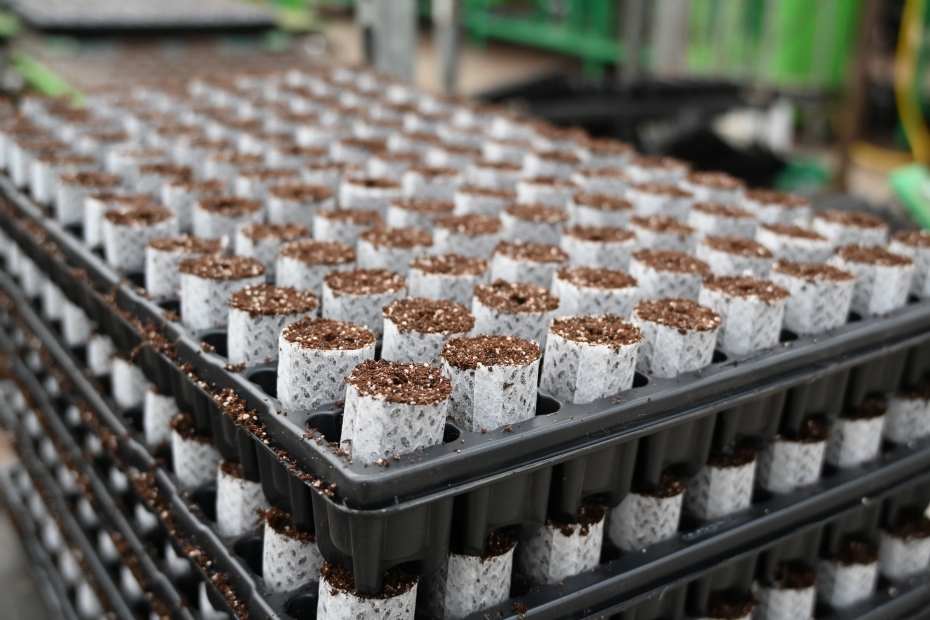Tree Nurseries prepare for the future with Paper Pots |
|
| GARDEN AND PARK TECHNOLOGY |
|
|
|
|
 |
| 178 sec |
Efficiency, Uniformity, and Automation
The use of paper pots is cautiously gaining ground in tree nurseries, a sector increasingly subject to automation. These paper pots can help nurseries to plant out faster, improve plant growth, and increase uniformity. But what does this mean for nurseries in practice? Rico Scheffers (OptiPlug) and Maarten Bloemen (Bloemen Young Plants) share their insights.
| Maarten Bloemen (Bloemen Youngplants) with the paper pots from Optiplug |
Paper pots were developed in Japan in the last century to plant cuttings faster and with less damage to their fragile roots. This clever system quickly spread to other parts of the world, including the Netherlands. OptiPlug, a family business in De Lier, has specialized in the production of paper pots since 2012. Rico Scheffers, co-owner with his father, has since grown the company into a serious player in the industry. "We produced 185 million paper pots last year; this year we aim to reach 200 million."
Paper Pots
Paper pots are small, biodegradable pots made from paper or cardboard, in which seeds are cultivated. They are designed to be planted directly into the ground with the plant. "We use machines that wrap rolls of paper around a hollow tube. A vacuum system then fills these with substrate, after which we cut the 'sausage' to size," explains Scheffers.
Tree nurseries looking to optimize their production process can get started with paper pots right away. "We deliver them ready-to-use, tailored to the growing needs of the customer. Together we determine the right length and size, for example, longer plugs for tree nurseries," says Scheffers. The content of the pots is also variable. "We develop custom 'recipes', for instance, a substrate with a low pH value for tree nurseries."
|
|
"Healthy roots grow faster into the next phase. Because they suffer less damage, there is less fallout."
| |
|
 | | Paperpot system from Optiplug |
|
|
Faster, Healthier, and Uniform
Paper pots help nurseries to plant out faster. "With a paper pot, you can pick up a plant as soon as it has a small root," says Scheffers. Traditional growing trays, often filled with loose soil, make this more challenging. "These trays are cheaper, but it's harder to repot quickly. Often you end up damaging the roots or the plants aren't sturdy enough for a larger pot."
Another important advantage of paper pots is that the roots remain intact, which reduces damage and loss. "Healthy roots grow faster into the next phase. And because they suffer less damage, there is less fallout," explains Scheffers. This means that nurseries quickly recoup the additional costs of paper pots. "Cutting farms benefit from this. It prevents complaints like, 'There were 104 cuttings in the tray, but we can only use 80.'"
Additionally, the use of paper pots leads to more uniform plant growth. "With traditional trays, the filling is often uneven, leading to growth variation. With paper plugs, you get a more consistent whole," says Scheffers. "We produce virtually identical pots, which leads to more uniform plants." The airy structure of the paper pots also promotes better root development. "Roots need less strength and grow more easily around the entire plug. This contributes to healthy plant growth."
|
|
"Tree nurseries want to pot less manually and are switching to machines. These machines need a shape-stable plug"
| |
|
Future-Proof
OptiPlug primarily produces pots for cutting companies with bedding plants or houseplants, but paper pots also offer advantages for longer crops. "The tree nursery sector has been increasingly using paper plugs, but most nurseries still use traditional growing trays," says Scheffers. Yet the application of paper pots in the sector is growing rapidly. A key reason for this shift is automation. "More and more tree nurseries don't want to pot manually anymore and are switching to machines. These machines require a shape-stable plug," says Scheffers. "Our paper pots perfectly meet the requirements of these new automated systems."
 | | Rico Scheffers |
|
|
Experience of Young Plants
Maarten Bloemen from Bloemen Young Plants, a plant material company that produces semi-finished products for nurseries across Europe, has been using paper pots from OptiPlug for over a year. "The success rate of the cuttings is important to us," says Bloemen. "Quality is everything, and the paper pots contribute to this. A strong cutting is the basis for a healthy plant and determines the growth process in the new pot, our eventual marketable product."
Bloemen is enthusiastic about his experience with paper pots. "Everything is now almost perfect. The paper pots are neatly produced, with the right moisture content and delivered as agreed. This is a world of difference from our previous supplier, where things often went wrong." Whether it's faster, he cannot say, but according to Bloemen, the quality is certainly better. "We see less damage to the roots and a more uniform expectation. This fits exactly with what Bloemen Young Plants wants to do."
Long-Term Cost Savings
A common objection to paper pots is the cost. "Tree nurseries often already have machines to fill growing trays with loose soil. Ordering paper pots then seems like an extra cost," acknowledges Scheffers. He points out that it is important to look at the overall picture. "The initial costs are higher, but with a good calculation, nurseries see that the investment pays off quickly. With paper pots, tree nurseries can sort or repot faster without damaging the roots. As a result, the roots stay healthier and the plant grows stronger. Less fallout allows a tree nursery to save costs."
This article was previously published on March 18, 2025, on the website of Boom In Business.
| LOG IN
with your email address to respond.
|
|
|
| There are no comments yet. |
Tip the editors
|